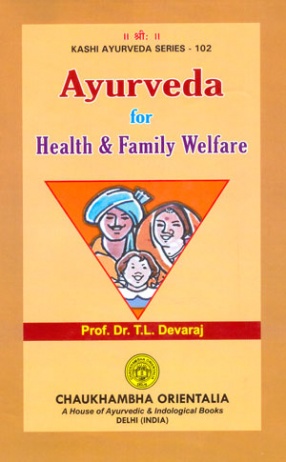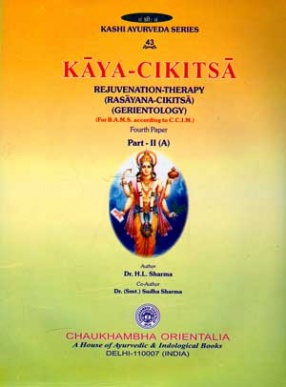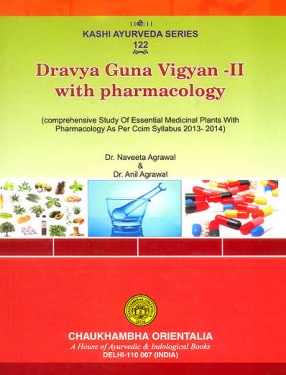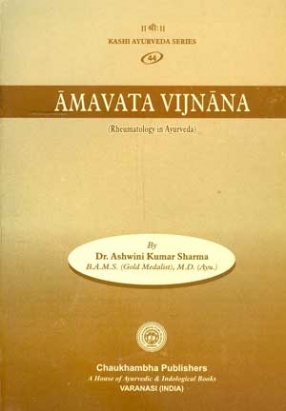
Kashi Ayurveda Series

Showing all 18 books















“I have never understood, why the human anatomy and complex body systems, at least at the fundamental level, were neither included nor compiled ever with any published work in herbal medicine? It is my strong conviction that without the basic knowledge of the human body, no system of medicine, including herbalism can accomplish the desired goals.
Whenever, I opted to buy a book on herbal medicine, I found nothing but the nomenclature of herbs, their ...


The book Ayurveda for Health and Family Welfare is the first book in the history of Ayurveda. There is a vivid description about maintenance of health through Swastha Vritta, Dinacharya, Ritucharya, Brhamacharya, sleep, exercise and practice of Yoga. This book consists of 4 parts first part A deals with Swasthavritta which is essential to people in this so called civilized world to get their bodily and mentally ailments cured or atleast prevented. Part B: Deals ...

Rajamartanda is an ancient medical text written by the Hindu King Bhoj Maharaj, a contemporary of the great Sanskrit poet Kalidas. This book gives many herbal recipes to cure the diseases of mankind. Control of diseases of the head, ear, eye, nose, face, chest, stomach, leprosy, haemophilic disorders, colds, catarrah harsh voice, chronic cough, asthma, hiccup, tuberculosis, throbbing pains, diarrhoea, dysentery, diabetes mellitus, urinary stones, sex organ ...

The book “Treatment of Complicated diseases with Ayurveda Medicine” is the first of its kind available, the students of Ayurveda feel frustrated when ever the complicated diseases came to them. With Authors experience of three decades of treating several complicated diseases with Ayurveda, he had come out with a book which is useful to students, Practitioners and Vaidyas of Ayurveda in their day to day practice. It is a must for all Post-Graduate and ...

Ayurveda is the Science of life deals with ways and means of protecting and preserving the health of people. It promotes good health through daily regimen, seasonal regimen, rules of healthy living, rules of good behaviour and chapter, proper sleep, proper intake of food, proper sex with intake of healthy and sex promoting drugs. There are other several factors that are advocated by Ayurveda for a healthy body and mind.The relevant photographs of plant and ...

Ayurveda the 'Scince of Life' is eternal is its scope and progressive in its outlook towards the concept of longevity. The beautiful concept of 'Rasayna Therapy' aims at rejuvenation, immunomodulation and also geriatric care. It is of great relevance today in a society which is stressed, unhealthy and has compromised immune system. Our ancient seers recognised the importance of this 'Rasayana Therapy' and it is thus included in main eight branches of Ayurveda. It ...

In Ayurveda there is a line of treatment for Cancer, external application, internal administration of medicines, herbal and metallic drugs which are purified and made fit to use by human beings. The Ayurveda not only cures the diseases but also rejuvenates the tissues of the body. It increases the resistances of the body by increasing immunity against the diseases producing organisms. Ayurveda treatment not only tones up the systems but also act as a tonic to the ...

Like my earlier book 'Clinical Methods in Ayurveda', this book also has emerged out of my lecture notes prepared for teaching the students of the Govt. College of Indian medicine, Mysore during 1962-1971. it was first published in kannadain 1972 by the Karnatak university, Dharwad. Dr. Kalyana Sharma M.D. (y) one of my students translated it into Telugu and published it in 1978. I was happy to learn from him later, that it is being eagerly sought for by the ...

In recent times, some Allopaths, a few of whom are very good scholars too, have taken to the practice of indigenous system of medicines, but, unfortunately, they have not yet come to be aware of the fact that the greater portion of Ayurveda, which deals with chemistry and Alchemy, has for the several centuries past, been a terra incognita to that class of physicians from whom they had to receive their training. They have not yet ben aware of the fact that the ...

This book Amavata Vijnana or Rheumatology in Ayurveda is a sincere effort in this direction. It has explained in a very simple language the intricacies of Amavata, Sandhivata and Vatarakta. A very good correlation between the pathogenesis both from modern and Ayurvedic point of view is a highlight of this book. It contains excellent photographs that will help the reader to visualize the conditions very easily.

The present study is based primarily, on the Caraka-Samhita, Susruta-Samhita and other oldest available texts on Ayurveda. An attempt is made here to present a detailed account of some of the nonclinical aspects of Ayurvedic principles and applications of health care, with a special reference to rejuvenation as found in oldest Ayurvedic Texts. Incidentally, some general and specific problems regarding the identifications of medicinal plants are also discussed.

Ayurveda has its own characteristics. It dos not lay more emphasis on materialism like modern medical sciences. It rather emphasis purity of mind, thought and action. Since it is devoid of materialism, not mor is visible. It can only be felt, realized, sensed, perceived through experience only. Hence a lot depends on imagination and estimation which sometimes may go wrong as well. Hence, insight plays an important role in Ayurveda but today is a scientific era ...

Dhanwantri Nighantu, when it was composed, is still to be traced. However, it can be said with certainty that Dhanwantri Nighantu is principle text of Ayurveda as far as description of medicinal plants is concerned. The plant have been arranged in distinct seven groups. Medicinal plants mentioned in seven groups have been discussed with respect to synonyms, Ayurvedic pharmacology and action on three biological homours, actions and therapeutics. A complete chapter ...
